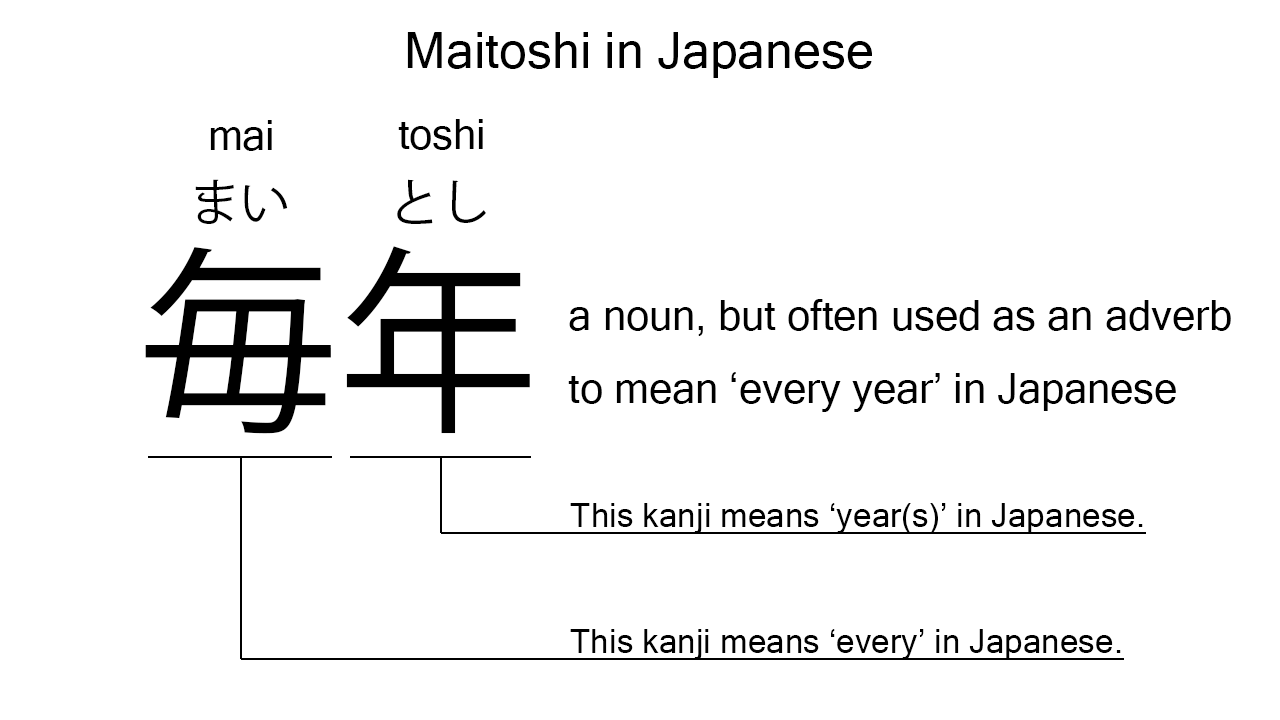What does “maitoshi” mean in Japanese?
Native speakers say “maitoshi” to mean ‘every year’ in Japanese. Perhaps, some Japanese learners know this word as it is sometimes used in Japanese conversations. In this blog post, however, I will explain this word in detail based on its kanji expression. And also, I will explain how to use it through example sentences. My explanations would help Japanese learners understand “maitoshi” more clearly. Then, let’s get started!
Contents
Definition and meaning of “maitoshi”
Let me start with the definition and meaning of “maitoshi”.
- maitoshi – 毎年 (まいとし) : a noun, but often used as an adverb to mean ‘every year’ in Japanese.
Grammatically this is a noun, but can also work as an adverb. In Japanese, many time-related nouns can also work as adverbs. “Maitoshi” is one of them. It can therefore work almost anywhere in a sentence to say “every year” in Japanese. Perhaps this fact sounds a bit weird to Japanese learners, but this is not unique to the Japanese language. For example, “tomorrow” can work as both a noun and an adverb in English. So, Japanese learners, especially those who are familiar with English, can easily understand this point, I think.
The definition and meaning are simple and clear. To understand this word more clearly, however, let me explain its kanji characters in detail, one by one.
Maitoshi in kanji
The kanji expression of “maitoshi” consists of the following two kanji characters:
- 毎 : a kanji character often used as a prefix or suffix to add the meaning of ‘every’.
- 年 : a kanji character used to mean ‘year’ in Japanese.
These two kanji characters tell us that “maitoshi” literally means ‘every year’ in Japanese. What the kanji characters express is completely in line with the actual meaning.

When we meet new kanji expressions, we should check their kanji characters in detail to understand their meanings clearly and deeply. In many cases, kanji characters tell us a lot about the meanings of the expressions they form. Actually, here, we could get the better understanding of “maitoshi” through the detailed kanji check above.
So far, I’ve explained the definition and meaning of “maitoshi” together with its kanji characters. Then, let me explain how to use it through the example sentences below.
Example #1: how to say “every year” in Japanese
watashi wa maitoshi nippon ni iku – 私は毎年日本に行く (わたしはまいとしにっぽんにいく)
I go to Japan every year.
Below are the new words used in the example sentence.
- watashi – 私 (わたし) : a pronoun meaning ‘I’ in Japanese.
- wa – は : a binding particle working as a case marker or topic marker. In the example, this works after “watashi” to make the subject in the sentence.
- nippon – 日本 (にっぽん) : a noun meaning ‘Japan’ in Japanese.
- ni – に : a case particle used to say where someone or something goes. In the example, this is used after “nippon” to say where the speaker goes every year.
- iku – 行く (いく) : a verb meaning ‘to go’ in Japanese.
This is a typical usage of “maitoshi”. In the example, it works as an adverb in the middle of the sentence to say “every year” in Japanese.
Example #2: another usage of “maitoshi”
maitoshi tokyo de imouto ni au – 毎年東京で妹に会う (まいとしとうきょうでいもうとにあう)
Every year I meet with my little sister in Tokyo.
Below are the new words used in the example sentence.
- tokyo – 東京 (とうきょう) : a noun meaning ‘Tokyo’ in Japanese.
- de – で : a case particle used to say where someone does something. In the example, this is used after “tokyo” to say where the speaker meets with the little sister.
- imouto – 妹 (いもうと) : a noun meaning ‘little sister’ in Japanese. This can also work as plural. Learn more about Japanese plural.
- ni – に : a case particle used to say in which direction an action goes. In the example, this is used after “imouto” to say to whom the action described by “au” is directed.
- au – 会う (あう) : a verb meaning ‘to meet’ in Japanese.
This is another typical usage of “maitoshi”. In this example, it works at the beginning of the sentence to say “every year” in Japanese. When we want to say “every year” in Japanese, anyway, this word is always a very good option.
Summary
In this blog post, I’ve explained the definition and meaning of “maitoshi” in detail based on its kanji expression. And also, I’ve explained how to use it through the example sentences. Let me summarize them as follows.
- maitoshi – 毎年 (まいとし) : a noun, but often used as an adverb to mean ‘every year’ in Japanese. These two kanji characters literally mean ‘every year’ in Japanese. So, what the kanji characters express is completely in line with the actual meaning.
Hope my explanations are understandable and helpful for Japanese learners.
Leave a Reply